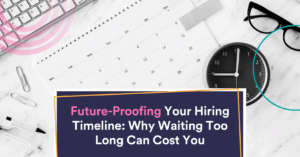Future-Proofing Your Hiring Timeline: Why Waiting Too Long Can Cost You

For many organisations, recruitment is treated as a reactive process. A vacancy arises, a business case is raised, and only then does the hiring process begin. While this may seem natural, it often creates unnecessary delays that put you at risk of losing top talent and paying the price in lost productivity.
Future-proofing your hiring timeline means anticipating business needs, planning ahead, and acting early. By preparing in advance, you not only improve the quality of hires but also strengthen retention and reduce overall recruitment costs.
Here is why waiting too long to hire can cost you, and how to build a timeline that works for your business.
Why Delays in Hiring Are So Costly
Every unfilled role comes with a price. Existing staff are often asked to take on additional responsibilities, which can increase stress levels and raise the risk of burnout. Projects may stall, deadlines slip, and client service can suffer.
The financial impact is also significant. A vacant position often results in lost productivity, reduced efficiency, and missed opportunities for growth. In senior or specialist roles, these gaps can have consequences that far outweigh the salary being saved.
For example, leaving a Finance Manager role unfilled for several months may result in missed reporting deadlines, weaker forecasting, and additional strain on senior leaders. On top of this, delays increase the chance of losing your chosen candidate. High-calibre accountants are typically on the market for only a short time, and if the process drags on, they are likely to accept another offer.
Understand Notice Periods and Lead Times
One of the most common causes of delay in hiring is overlooking notice periods. Many professionals, particularly at senior levels, are required to give three months’ notice. That means if you want someone to join your business in January, the recruitment process needs to start now.
Working backwards is essential. Beginning the process in October gives you just enough time to identify candidates, conduct interviews, and finalise offers, so your chosen hire can give notice and be in place at the start of the new year. This forward planning ensures your business has the right people when they are needed most.
Budget Planning and Stakeholder Alignment
Another cause of delay is internal. Hiring managers may identify the need for a role but wait for budget approval, or stakeholders may not be aligned on what they want in a candidate. These delays create a bottleneck that frustrates candidates and weakens your position in the market.
Agreeing budgets and role requirements in advance ensures that when the right candidate comes along, you are ready to move quickly. This alignment not only speeds up the process but also improves candidate confidence, as they experience a smooth and decisive hiring journey.
The Hidden Cost of Losing Momentum
Recruitment is not just about processes; it is about relationships. When candidates feel that progress has stalled, their interest begins to fade. A slow process may give them the impression that your business lacks organisation or urgency.
This loss of momentum often results in candidates withdrawing themselves from the process, or worse, accepting an alternative role where the hiring experience felt more positive and decisive.
Future-Proofing Through Talent Pipelines
One of the best ways to avoid costly delays is to build and maintain a talent pipeline. Rather than waiting for vacancies to arise, proactive businesses engage with potential candidates on an ongoing basis.
This can include keeping in touch with professionals you have previously interviewed, building relationships through LinkedIn or networking events, and working with a trusted recruitment partner who has access to passive candidates. By nurturing these connections, you shorten the time it takes to hire when a role does become available.
The Benefits of Acting Early
Future-proofing your hiring timeline is not just about avoiding problems; it also creates opportunities. By moving early, you:
- Access a wider pool of candidates before competitors approach them
- Allow more time for thorough assessments without losing momentum
- Give candidates greater confidence in your organisation’s planning and structure
- Improve the likelihood of aligning start dates with business needs
The result is a smoother, faster, and more cost-effective recruitment process.
Key Takeaways
Delays in recruitment can cost businesses much more than they realise. Lost productivity, added pressure on existing staff, and missed opportunities are all common consequences of waiting too long to hire. By anticipating future needs, aligning stakeholders, and factoring in notice periods, employers can move faster and more effectively when the right candidate becomes available.
Future-proofing your hiring timeline not only reduces risk but also creates opportunities to secure top talent ahead of your competitors.
If you would like practical guidance on planning your hiring strategy or support in building a proactive talent pipeline, get in touch with CMA Recruitment Group.

